
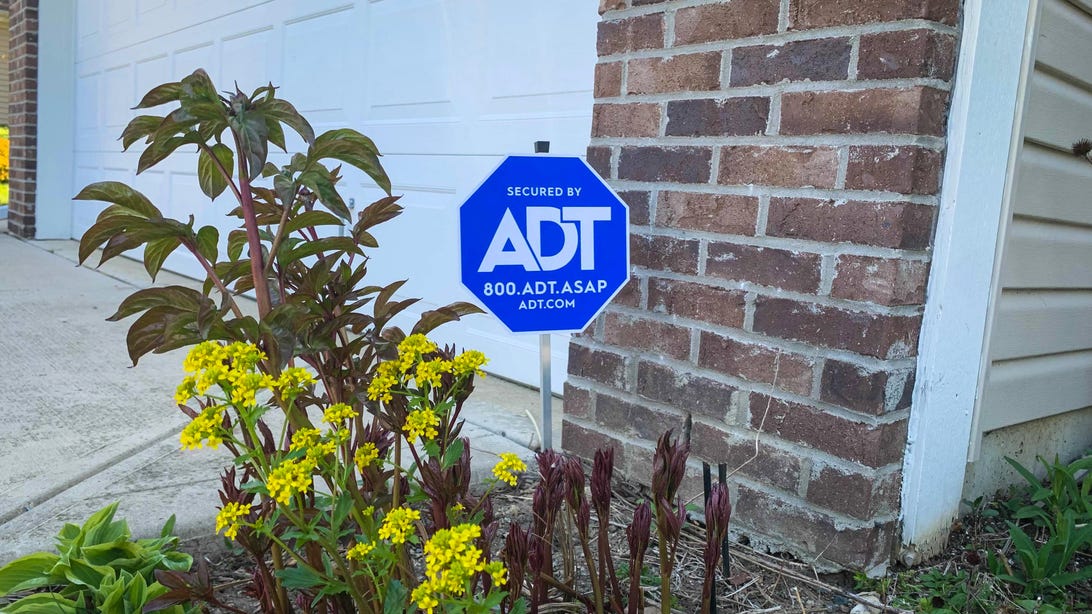
David Priest/CNET
ADT is the granddaddy of all home security companies. It’s been around in one form or another for close to 150 years, and it remains one of the most recognizable brands on the market — if not the most. But ADT faces an evolving and ever-modernizing marketplace. Thanks to direct competitors like Comcast Xfinity and Vivint, along with a host of DIY home security options including innovative contenders like Ring Alarm Pro, traditional contract-based services like ADT are becoming relics of a past era.
The company is working to rise to the occasion. In 2020, ADT started integrating with Google Nest home automation devices, including its smart cams and Google Assistant-equipped Nest Hub smart displays. And in April 2021, ADT began installing and selling Nest products. This means existing ADT costumers now have the option of controlling their security systems with Google Assistant through voice and touch control using a Nest Mini, Nest Hub or Nest Hub Max.
But even with those updates, ADT probably isn’t worth its steep price. Despite the system performing adequately, its poor user experience, clunky design and high prices make it one of the least enticing professional home security systems on the market.
Don’t Like
- Too expensive
- Painful installation
- Poor passcode security measures
- Clunky app design
How we test
Before diving in with our ADT review, a little context might be helpful. While CNET has historically tested plenty of smart home security devices — and even DIY security systems — our professionally installed home security system coverage has been a little sparser. In 2021, we decided to change that, testing every major home security provider in the industry, from professional systems like ADT and Vivint to DIY systems like Ring and Wyze. With this ongoing project, we’re trying to give the fullest and most up-to-date information on which system is best for you.
Here’s how we test: First, we either purchase the system ourselves or work with the company to acquire it for testing purposes, to be returned afterward. For professionally installed systems like ADT, we schedule an installation with technicians like any customer would, then follow their instructions and suggestions carefully.
Once everything is up and running, we test each device individually, making sure it accomplishes what it should (like, does a motion detector detect motion?). Then we see how the system works as a whole, looking for things like what integration options are available and how accessible controls and triggers are.
These systems are tough to rate, in part because each one presents a different vision for how home security can look: Some focus more on security, some emphasize smart home devices. Some lean more on a central hub, while others work best with an app. My goal is to judge each system according to its own standards, essentially asking what it’s trying to do, then if it does it. But no system exists in a vacuum, and sometimes I’ll point out when a system doesn’t try to do something, but should.
In short, I’m testing each system to make sure it delivers on its promises; and I’m asking how, as a full package, it stacks up against the packages offered by competitors.
A painful installation
I tested ADT’s home security system over the course of two weeks, and my time with it was for the most part unremarkable. But the installation process stood out as particularly painful.
Like many other home security companies, ADT sends professionals to your house to help determine the best setup for your needs. Once you figure out what you want installed, technicians set it up for you. For the purpose of this review, I wanted my setup to include at least one of every type of device — which resulted in an installation of a similar scale to what most customers might get, but not of a similar makeup, as I’ll discuss later.
The three ADT employees who came to my house were polite and professional, responsive to any questions and requests I made, such as angling cameras specific ways. But the installation experience was far worse than, say, Vivint’s — the system I tested only a few weeks before ADT.
The first problem was the length of time it took. The sales reps arrived at 8 a.m., and the technician finished his work just after 5 p.m. We decided on the array of devices to install in about an hour, and the remaining 8 hours were just spent on setup.
That might not seem unusual, but let’s compare with a competitor for a moment. Vivint’s system took only a bit over 7 hours total to install, and included almost all the same devices ADT provided, plus eight extra door/window sensors, a second mounted outdoor camera, a car monitor, an external hard drive for video backup and a handful of extra sensors of various sorts. In short, it took less time for Vivint to install many more devices.
This wasn’t a shortcoming of my individual technician (though that will always be an uncontrollable variable in these situations), but of the process. Vivint had all three professionals present help with setup. Only one of ADT’s three professionals took an active role in installing devices.
When I asked, ADT told me this approach and time frame for setup was standard.

One key piece of the installation was setting a passcode, which can be used on the central hub and tablet to disarm the system.
David Priest/CNET
The second issue with installation was its intrusiveness. For liability reasons, someone must stay in the house during setup — which is typical for professional security installations. About 15 minutes at the end of the process required testing incredibly loud alarms for each device in the system, though. My home is over 3,000 square feet and two stories, but even on a separate floor, my father had to step outside to take a phone call and my 3- and 5-year-old boys shut themselves in their room and covered their ears for the duration of the testing. Testing alarms and pinging monitoring services was much less involved for both Vivint and Xfinity — both were brief and quiet.
Finally, and most seriously, the installation did not encourage good passcode security. When one of the installers helped explain the system to me, he set 1-2-3-4 as my passcode. I was neither required nor advised to change this passcode later on; considering how popular 1-2-3-4 is as a four-digit passcode, this felt irresponsible.
When I asked ADT about this practice, they said it was not standard. According to the company, reps usually “learn the customer’s requested four-digit passcode [and enter it] into the system for them and instruct them on how to change it. … Upon your recommendation that you would play with the system yourself so you could determine how user-friendly the system is, the ADT team did not go too deep into the demo or into [discussing] the change of the pass ode once they had left.”
It’s possible that my presence as a reviewer changed my experience, but I only mentioned my intention to play with the system after the 1-2-3-4 code had been set, so it seems unlikely that my comments affected the initial setup, which was the most troubling part of the installation to me.
Again, many of my criticisms here are not of the individual installers who helped me, but of the company procedures that are — or aren’t — in place. When my technician accidentally wired my thermostat to send out heat after the temperature was turned down, I called the number he left and he was able to help within a few hours. I was impressed with customer service’s responsiveness.
Security and smart home devices
Once it’s installed, ADT’s system lets you monitor your home effectively. Across flood sensors, smoke and CO detectors, glass break sensors and door/window sensors, you’re pretty well covered, whether you’re arming the system for the night or setting it to away mode for a week while you’re out.
As with many security systems in 2021, you also get some smart home functionality. If you’re lying in bed, you can check that your smart deadbolt is locked and make sure your thermostat is set to the cool 67 degrees you like when you’re sleeping. You can also set and automate routines, so devices automatically respond to your behavior.

ADT’s connected thermostat can adjust the temperature based on whether you’re home or not.
David Priest/CNET
The center of ADT’s whole system is the control panel… and the app… and the online portal. This is the primary problem with the system as a whole: You can’t rely on any one of these control centers to meet all your needs.
On the control panel, you’re mostly limited to arming your system, checking camera feeds and device states and activating various routines (such as locking your door and turning off all the lights). This is fairly standard as far as professional security systems go. The control panel is convenient, but it doesn’t let you do much beyond the basics.
Using ADT’s app you can do all the same things, and also create routines and access more specific device settings. The problem is, all of these options are hidden behind unintuitive menus and icons. If you want to change your camera recording rules, for instance, you don’t tap the device on your home screen. You open the hamburger menu, select the device and finally tap the gear symbol in the corner of the screen. The “Recording Rules” screen then takes anywhere from 5 to 20 seconds to load, at which point you can adjust when your camera records and when it doesn’t.
In short, the app is clunky. Worst of all, you can’t actually set up any automations in it. For that, you’ll need to use the third control center: the online portal.
When I first started testing ADT’s security system, I thought it might not allow basic automations such as setting your entryway lights to flip on when your front door opens. When I emailed ADT’s representatives asking about it, they directed me to the online portal, a website that looks like an enriched version of the mobile app. There you can monitor your camera feeds, arm your system and adjust device settings, and you can also create automations.
This portal gives you much more control over your smart home experience, but it’s also annoying to use. You have to use a web browser to access the portal, which means no automating with a few taps in an app when the idea strikes you. ADT’s site itself isn’t particularly difficult to access — it’s just a quick login, without two-factor authentication, for better (convenience) or worse (security). For comparison, Vivint didn’t require you to use its website for particular functions, and Xfinity didn’t use an online portal at all.
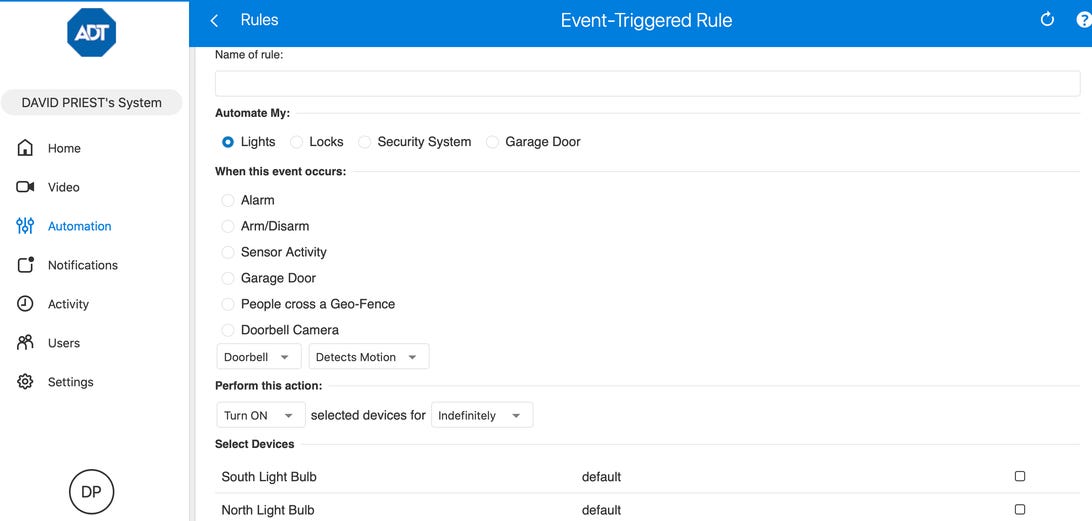
ADT’s online portal lets you create various automations, but it’s disappointing the feature isn’t on the app.
David Priest/CNET
That said, ADT offers much more customizable automations than, say, Comcast Xfinity, allowing you to trigger most devices with most other devices. Want your lights to flip on when a camera detects movement? Check. Want your camera to record when your deadbolt unlocks? Check. Want your thermostat to save power when your motion detectors don’t sense you around the house? Check.
But is a larger monitor or keyboard necessary to use this portal? Not really. It’s disappointing that so many of these smarts are relegated to an online platform many customers may not be fully aware of, or may find inconvenient.
The cost of admission
Before looking at the cost of the hardware, let’s take a look at the monitoring services ADT offers. Basic alarm monitoring starts at $39 per month (versus $30 per month for Vivint or Xfinity), but if you want to use the smart home automations I talked about before and video storage, you’ll need to shell out $60 per month (at Vivint, the equivalent plan costs $45 per month; Xfinity doesn’t charge extra for automation features, and charges $40 per month to include video services).
In addition, ADT requires contracts that vary by region from 12 months to 60 months in length. Cancellation fees for these contracts are steep: ADT can charge as much as 75% of the remaining balance due according to the contract.
ADT says the reason for contracts is to make purchasing the system affordable for people in different financial situations.
“ADT subsidizes the upfront cost of the customers’ security and automation equipment,” a company representative told me in an email, “which is how we can offer no [or] low upfront fees.”
With all the DIY options on the market, and the growing trend among professional security services to avoid contracts in favor of giving customers freedom to pay for hardware up front or in installments, it’s disappointing to see ADT still require them. ADT told me contracts are “standard practice in the industry,” though Vivint, Comcast Xfinity and other professional home security companies don’t require them.
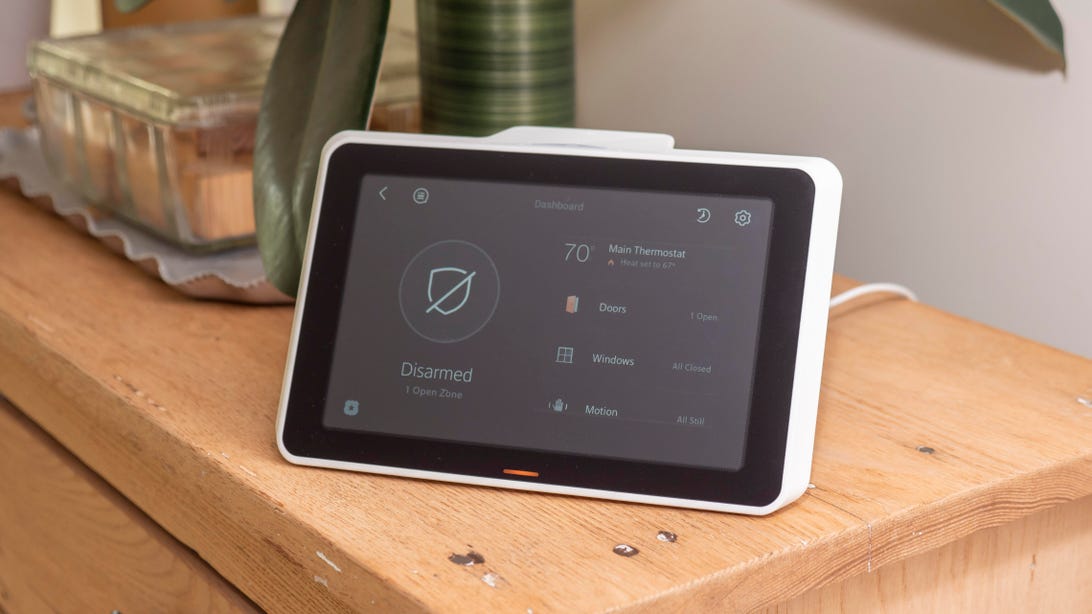
ADT requires a contract.
Josh Goldman/CNET
That said, if you’re already planning to pay for the hardware on a monthly payment plan, a short contract may not interfere with your plans.
ADT’s hardware is also more expensive than DIY devices we’ve tested and liked from SimpliSafe, Abode and Ring Alarm, but how does it stack up against other professionally installed and monitored systems? First, let’s take a look at the breakdown of my ADT hardware bill:
- Touchscreen hub: $374
- Cell backup: $75
- Door/window sensors (x3) and Motion sensor bundle: $150
- Touchscreen control tablet: $200
- Charger for tablet: $50
- Wireless touchpad: $150
- Desktop mounts for touchpad and hub: $100 ($50 each
- Key fob: $50
- Indoor siren: $90
- Smoke detector: $100
- Smoke/CO detector: $180
- CO detector: $100
- Glass break detector: $100
- Flood sensor: $100
- Temperature sensor: $100
- Z-wave smart lights: $60 for a two-pack
- Indoor smart plug: $70
- Outdoor smart plug: $70
- Smart thermostat: $160
- Z-wave deadbolt: $250
- MyQ: $220
- Video doorbell: $200
- Indoor camera: $150
- Outdoor camera: $290
My installation came to a grand total of $3,387 — though that number won’t be representative of most people’s setups. First off, I didn’t fully cover all the entrances on the first floor of my house with door/window sensors, which would’ve added as much as $450 to my overall bill. Second, I made sure to get at least one of all the major device types — which means smart plugs and multiple types of smoke or carbon monoxide detectors — which probably isn’t what the average user would do. That said, the $3,000 to $4,000 range seems in line with some competing systems, such as Vivint.
Let’s take a look at the devices that make up ADT’s security system and how good (or bad) of a deal they really are.
The basics
If you’re getting an ADT security system, you’re probably not angling for a bare-bones setup; one of the biggest appeals of professional systems is their scale, compared with DIY alternatives. That said, it’s still helpful to compare the base price of the core devices — a touchscreen hub with cell backup, three door/window sensors and a motion detector — to competitors’ systems. For ADT, those devices cost about $600, give or take a little (if you get a desk mount, it’ll be $50 more; if you get the smaller tablet and charger, it’ll be $175 less).
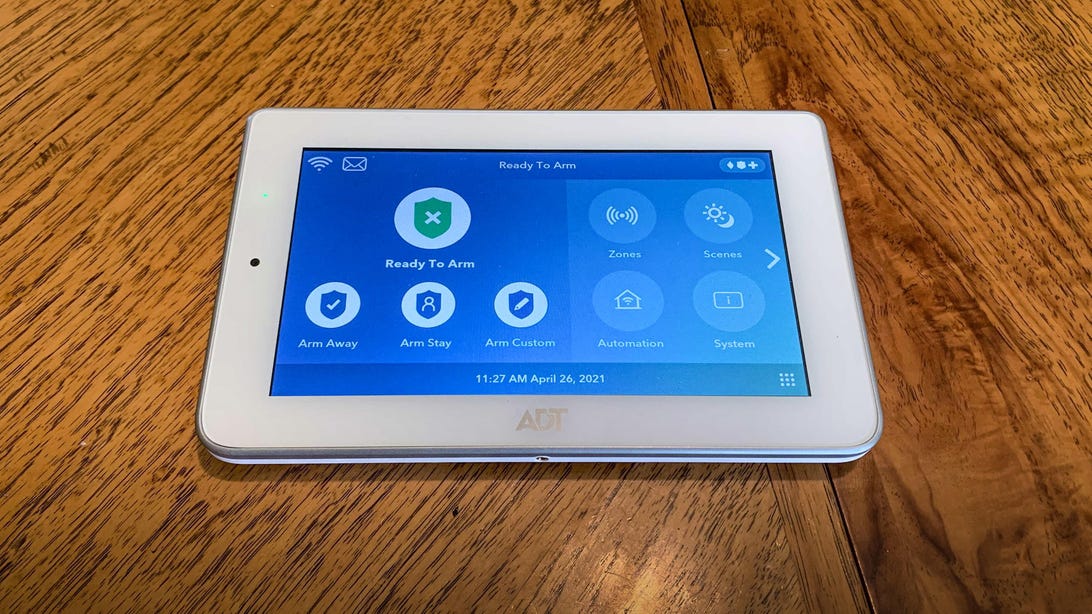
I preferred the more affordable tablet, which you can carry around the house with you, to the wired touchscreen hub.
David Priest/CNET
You can also go for a more traditional keypad and control the system using your app, but it wouldn’t save you that much money versus the tablet, and it would cut out a lot of usability.
Vivint’s package is $500 for a comparable starting setup that also includes a flood sensor. Comcast Xfinity’s is $360. Bottom line: ADT’s is the most expensive.
The sensors
The sensors in a home security setup aren’t as glamorous as the security cameras or video doorbell, but they’re the glue holding the whole system together. Door/window sensors let you know if someone’s coming through any of the points of entry into your home, motion detectors alert you to motion, smoke and CO detectors alert you to signs of fire or gas leak, flood sensors tell you if water is pooling somewhere and glass break sensors alert you to… well, you probably get the idea.
All these sensors tie together to help you monitor your house thoroughly, no matter what the situation. They can also help you create a really responsive living situation, if you take the time to automate it, where opening your front door triggers your coffee maker, or locking your door turns on the porch light.
In general, ADT’s sensors are competitively priced against some other professionally installed and monitored systems. ADT’s glass break sensors, smoke detectors and CO detectors cost the same as Vivint’s ($100). Its flood sensors are more expensive ($100 vs. $50) and its motion detectors are less expensive ($50 versus $100).
When you compare these detectors with Xfinity’s, o those from DIY companies like SimpliSafe, ADT’s prices are high — or hard to understand. Take as an example ADT’s door/window sensors, one of the most basic units in a home security setup. ADT doesn’t offer the option to purchase these devices individually. Instead, you can buy a sensor bundle for $150, which includes a personalized assortment of sensors of various types. If you just wanted door/window sensors, you could get six for $150 — which is not a bad deal (for the sake of comparison, you can get five Xfinity door/window sensors for $100, or eight SimpliSafe door/window sensors for $100).
The problem is, making sense of how the pricing works for your system isn’t straightforward. So even the better deals end up requiring some leg work to take advantage of.
The cameras
ADT’s cameras definitely beat Vivint’s on price. Its outdoor camera costs $290 (Vivint’s costs $400), and its indoor camera costs $150 (Vivint’s costs $200). Xfinity only offers one indoor/outdoor camera that costs $120.
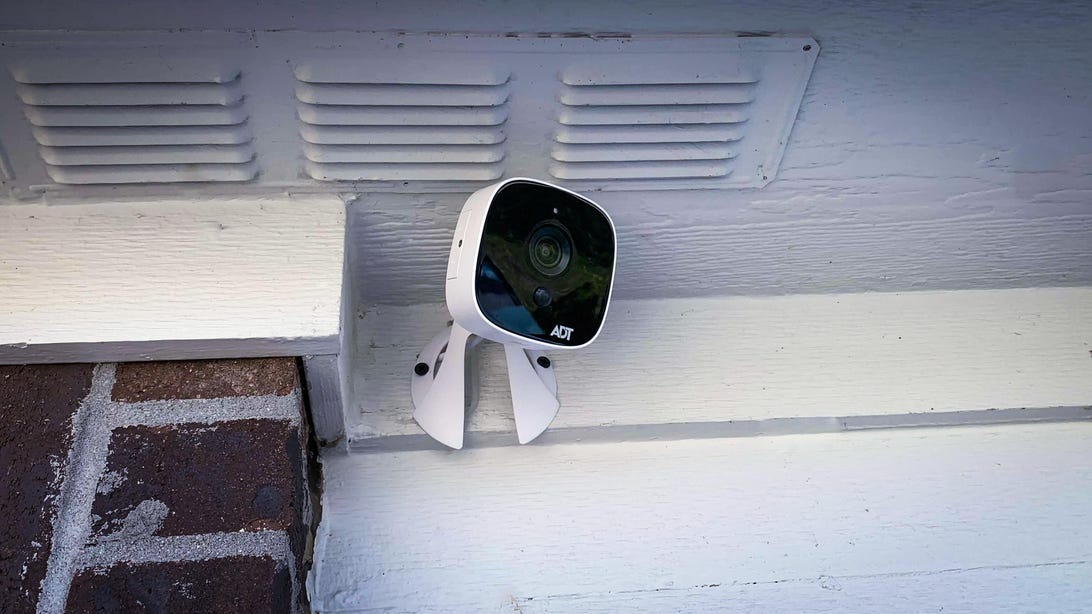
ADT offers both indoor and outdoor cameras.
David Priest/CNET
Whether those price differences are appropriate, though, largely depends on the quality of the device. ADT’s cameras are as basic as they come: They don’t distinguish between people and cars like Xfinity’s cameras, and they don’t provide automated deterrence messages if they detect motion like Vivint’s. Instead, they bring basic two-way audio, high-definition streaming and little else.
The video doorbell was especially disappointing. While Vivint’s video doorbell ($130) gives you a 1:1 aspect ratio for clear vision of your doorstep (and packages left there), ADT’s video doorbell ($200) has a wide-angle lens. In addition, aside from two-way audio, many basic features are missing. You can’t draw motion zones to avoid unnecessary notifications, and you can’t customize notifications based on whether a package has been left on your doorstep or a person is standing there.
Everything else
Aside from the central hub, arrayed sensors and cameras, ADT’s system is made up of a variety of helpful gadgets, from flood sensors and smart plugs to garage door openers and deadbolts. These devices use Z-Wave radio waves to communicate, meaning your routines won’t necessarily stop working if the Wi-Fi goes out.
Across the board, these devices worked well when I tested them. But they were also consistently overpriced. The Z-Wave smart plugs — which you can find online for under $20 — were $70 apiece. The Z-Wave garage door opener was $220, nearly $200 more than you can find it for online. ADT charges $250 for its Kwikset deadbolt; Vivint charges $180 for a comparable device.
For those with Google Nest devices, you can also arm and disarm your system with a simple command to Google Assistant. In addition, ADT’s lights, locks and thermostats are all voice-controllable.
In short, ADT’s hardware will work well for many people, but the value it offers for the price — even if you do own a Nest smart speaker or smart display — is simply too low.
Should you buy ADT home security?
Being the oldest company in a market doesn’t mean you have to act the oldest, but that’s what ADT’s home security does. Its dependence on the online portal for its best features — not to mention its continuing use of contracts — feels outmoded. A painful installation process with low passcode security standards is worse than outmoded; it verges on irresponsible.
Add in the expensive prices of the monitoring services and hardware, and ADT is one of the least appealing professional security services we’ve tested. That’s a real shame, because ADT’s smart home automation capabilities are impressive if you pay the extra cost and don’t mind using the portal — and the Google Nest integrations add some genuinely useful voice control to the whole equation.
It’s possible that ADT, as evidenced by its recent Google Nest integrations, isn’t totally stuck in the past. But that’s small comfort in the face of the prices and contracts that are still standard at ADT. For now, until the security company adopts better sales and installation procedures, drops its prices and overhauls its control interface, it will continue to feel like a relic in a quickly modernizing market.